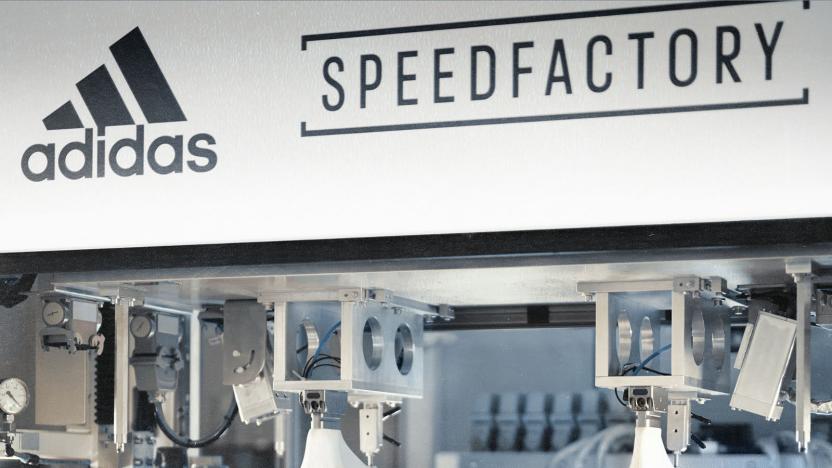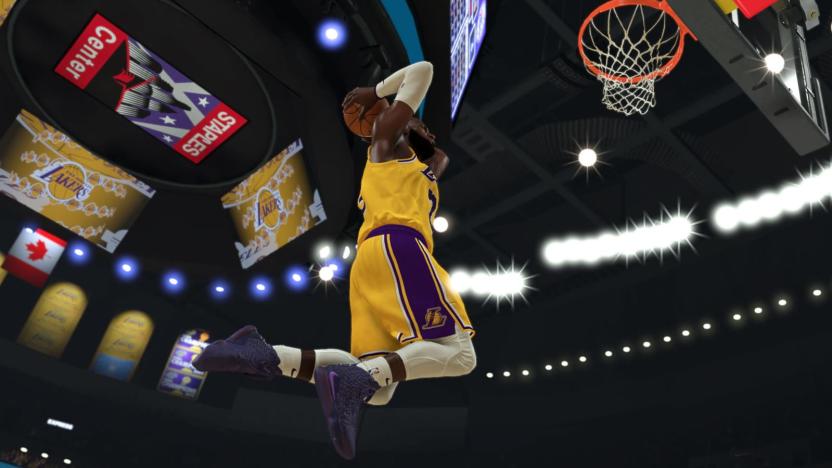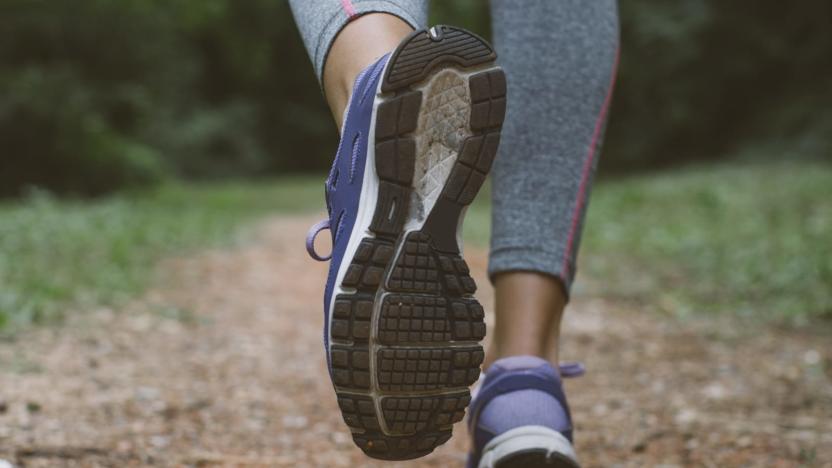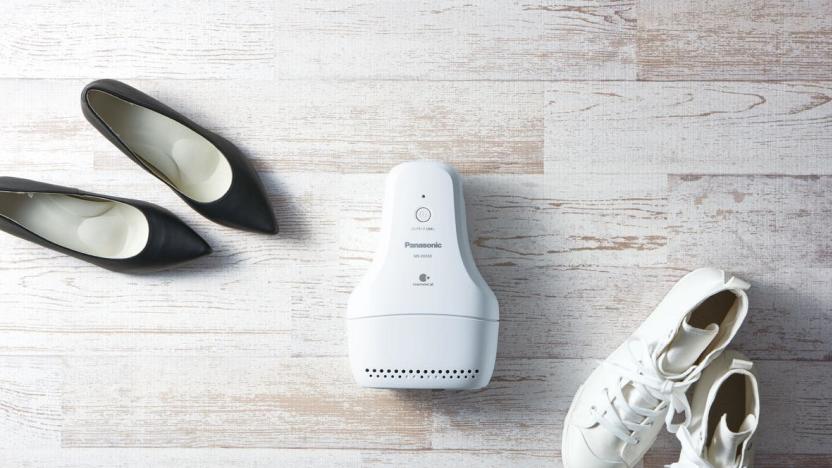shoe
Latest

How to buy sneakers for the hypebeast in your life
It's hard enough to find gifts for your loved ones during the holidays, but hypebeasts in particular are a picky bunch. They only want the most hyped products and the rarest sneakers, which can be a complicated world to navigate as a shopper if you're not familiar with it. But we're here to help. Thankfully, there are many ways to find something hypebeasts might like online -- even if you have to spend more money and time than you had hoped for. Here's how you can buy sneakers, apparel and even fanny packs (they call them waist bags) for the hypebeasts in your life.

Adidas abandons robot Speedfactories in Germany and the US
Adidas is abandoning its robot-staffed Speedfactories in Ansbach, Germany, and Atlanta, USA. Both facilities, which are run in partnership with German plastics specialist Oechsler, will be closed "by April 2020 at the latest," the company said in a press release. The sportswear giant stressed, though, that some of its Speedfactory processes would be adopted by two suppliers in Asia, where manufacturer is traditionally cheaper, later this year. Using these technologies, the pair will produce running shoes and, for the first time, models in "other product categories." Speedfactories were meant to bring sneaker production back to Western markets and lower Adidas' reliance on Asian suppliers, which have often been criticized for unethical working conditions and practices. Adidas also hoped that the Speedfactories would, as their name implies, accelerate production and reduce both the cost and time associated with shipping. The mostly-automated manufacturing produced a small range of sneakers including the Futurecraft M.F.G (Made For Germany) and a line of AM4 (Adidas Made For) shoes that were inspired by six of the world's largest cities and, later, select artists including DJ Kittens and JaQuel Knight. Adidas still has technological aspirations. Today, the company said it would further concentrate its resources on "modernizing its other suppliers" and, with Oechsler's assistance, continue to explore "4D technology," a 3D-printed midsole that has been used on sneakers such as the Futurecraft 4D and Alphaedge 4D. "Whilst we understand adidas' reasons for discontinuing Speedfactory production at Oechsler, we regret this decision," Dr. Claudius M. Kozlik, chief executive of Oechsler admitted today. "At the same time, we look forward to continuing our close and trusting cooperation with adidas in the area of 4D sole printing." For now, at least, sneaker production is safe from the seemingly inevitable automated-robot-factory-revolution.

Nike will drop exclusive, limited-edition sneakers inside ‘NBA 2K20’
Those of you who are into NBA 2K know that, for years, you've been able to buy sneakers from different brands for your virtual player in the game. But now, thanks to a new partnership between Nike and software publisher 2K Sports, you'll have a chance to get real sneakers for yourself as you're playing NBA 2K20. And they won't just be any kind of shoes -- they're going to be limited edition and exclusive to the popular basketball title. Nike says it will drop 10 "Gamer Exclusives" through NBA 2K20, starting on October 29th, when players will have the opportunity to purchase them by completing in-game challenges.

Nike puts an accessibility twist on its iconic Air Jordan 1
The Air Jordan 1, which NBA legend Michael Jordan debuted in 1985, continues to be one of Nike's most popular sneakers to this day. Throughout the years, the company has launched hundreds of different iterations of its iconic model, and now it's putting another twist on it that has the potential to help athletes and other people with disabilities. The AJI High FlyEase features Nike's FlyEase technology, one that was introduced in 2015 and is designed to make it easy for anyone to get their sneakers on and off quickly and easily.

Foot Locker wants to reinvent itself with a dedicated app for streetwear
Whenever you think of Foot Locker, what probably comes to mind are its thousands of brick-and-mortar stores, because chances are you've visited at least one in your lifetime. But, as important as physical retail locations are to the company's business, Foot Locker is also having to quickly adapt to the new ways people are shopping for sneakers, apparel and other types of gear. That's why back in February it invested $100 million in GOAT, one of the most popular apps for buying shoes on the resale market. And now, it is creating its own incubator called Greenhouse, which has just launched an app that Foot Locker says will feature carefully curated partnerships that are going to "contribute to [its] modern resurgence."

Nike's Joyride shoes use tiny beads to make your runs more comfortable
Nike has developed a new shoe technology for both casual and every-day runners. Today, the sportswear giant is taking the wraps off of Joyride, a responsive cushioning system designed to adapt to individual foot strikes and offer high levels of impact absorption as your feet hit whatever surface you're running on. Nike says the idea with Joyride is to "make running easy" and give you more personalized comfort, which is made possible by thousands of tiny, energy-packed beads that form the shoe's midsole. You can get a great look at them in the Joyride Run Flyknit pictured above, the first Nike sneakers to feature the visible and colorful beads.

Nike uses AR to help you find the right fit for your sneakers
Nike has been experimenting heavily with augmented reality for a few years now, and the company is continuing to work on new experiences powered by the technology. The sportswear giant is now introducing Nike Fit, a feature that uses a combination of computer vision, scientific data, artificial intelligence and recommendation algorithms to scan your feet and find the right shoe fit for you. And you can do it all in augmented reality, using the Nike app on your smartphone. Nike says that, according to industry research, over 60 percent of people wear the wrong size shoes. With Nike Fit, the company is hoping to solve that problem.

Puma is recruiting beta testers for its self-lacing sneakers
When Engadget took an exclusive look at the Puma Fi self-lacing shoes earlier this year, the company teased an upcoming beta program for those who want to try their luck. Well, the time has come. Between now and April 28th, you can apply for the Puma Fi beta testing program via the PUMATRAC app (available on iOS and Android) or Puma's online form. The catch is you need to be residing in one of the following 11 regions: US, UK, Germany, Japan, Hong Kong, Sweden, Denmark, Norway, Spain, India and Turkey.

Adidas made a running shoe that's fully recyclable
As part of its recent pledge to only use recycled plastics by 2024, Adidas has revealed a new running shoe that is made from 100 percent recyclable materials. The Futurecraft Loop was designed using nothing but thermoplastic polyurethane (TPU), a plastic material that dons the entire sneaker, including the tongue, laces, upper and the midsole with Boost cushioning technology. Adidas says it has been working on this project for the past six years, and the goal with it is to do its part in generating less plastic waste.

Self-repairing shoes may be a reality thanks to 3D-printed rubber
Shoes will invariably wear out with enough use, but scientists might have found a way to delay the shopping trip for their replacements. A USC team has created a self-healing 3D-printed rubber that could be ideal for footwear, tires and even soft robotics. The effort involves 3D printing the material with photopolymerization (solidifying a resin with light) while introducing an oxidizer at just the right ratio to add self-healing properties without slowing down the solidifying process.

Puma wants to let you try its new Fi self-lacing shoes
With the upcoming release of Nike's $350 Adapt BB, self-lacing shoes are set to become more commonplace, and Puma isn't about to let its rival take all the credit. After all, the German company showed off its own self-lacing sneaker, the Autodisc, back in 2015 -- around the same time as Nike's iconic (and ultra rare) Mag before it evolved into the HyperAdapt. The only problem was the Autodisc just wasn't practical enough to enter retail -- it was too expensive, too heavy and could have been more comfortable. But that's about to change with Puma's latest creation, the Fi (pronounced as "F-I" aka "Fit Intelligence").

Puma revives its 1986 smart shoe for the modern era
Smart shoes may sound like a recent innovation, but they're really old hat -- Puma's RS-Computer shoes were tracking your running stats in 1986, well before wearable tech was a hot trend. And Puma wants to remind you of that fact. It's reissuing the RS-Computer with the familiar colors and heel hump, but thoroughly modern fitness tracking technology. The 2018 shoe uses a three-axis accelerometer to measure calorie burn, distance and (new for 2018) step counts. And instead of plugging in a data cable to sync up to 30 days of activity data with an ancient Apple II or Commodore 64, you use Bluetooth to pull send information to an Android or iOS app -- albeit one that nods to the original 8-bit software.

Panasonic's deodorizer freshens your shoes while you sleep
In a world where self-driving cars are taking to the roads and computers are having casual conversations with salon receptionists, it's easy to forget that many companies are still working hard on solutions for low-tech, everyday problems. Smelly feet, for example. You'd think we'd have that nailed by now, but as Panasonic's newest launch demonstrates, there's still a lot of innovation to be had in this arena. Forget simply slapping a couple of scented insoles into your kicks -- Panasonic, the brains behind the deodorizing coat hanger, wants the business of shoe deodorizing to be a tech experience.

Under Armour’s HOVR smart running shoes are more than just a gimmick
As fascinating as shoes like Nike's "PlayStation" PG2s or Adidas' "4D" Futurecrafts are, those particular models don't offer many (if any) benefits to avid runners. They're more geared toward sneakerheads than anyone else. But, that doesn't mean there aren't any tech-oriented pairs designed for people who enjoy running, be it casually or on a regular basis. That's exactly the demographic Under Armour is going after with its HOVR connected shoes, which consist of two different versions: a low-top (the Sonic) and a mid-top (the Phantom, pictured here).

Nike’s 'PlayStation' shoes make hypebeasts out of gamers
It's not often we see a shoe that appeals to both the sneakerhead and gamer communities. But Nike managed to do exactly that with the PG2, the second signature model of professional basketball player Paul George, which features a design inspired by Sony's PlayStation console and its DualShock controller. Nike says that George, who plays for the NBA's Oklahoma City Thunder, worked closely with PG2 designer Tony Hardman to create an on-court shoe that would represent his love for gaming and, specifically, the PlayStation.

Nike’s ‘PlayStation’ PG2s are like a DualShock for your feet
Nike has never been afraid to use different technologies to experiment with its sneakers. After all, this is the company that brought you the Mag and HyperAdapt, two shoes powered by auto-lacing mechanisms. And while its latest basketball silhouette isn't as tech-forward as those, there's still plenty to like here, especially if you're both a sneakerhead and an avid gamer. Meet the PG2, Paul George's new signature shoe, which Nike created in collaboration with Sony and was inspired by the PlayStation. Sorry, Xbox, maybe next time.

A smart insole pairs with an app to track how tired you are
Two years ago, at CES 2016, we found a pair of smart shoes that could be "laced" by simply tapping a virtual button on a smartphone app. Now, the company behind those sneakers, Zhor Tech, has brought its latest creation to CES 2018: a connected shoe insole. The device is loaded with sensors that count your steps, detect your fatigue levels, analyze your posture and detect any rough vibrations around you. Zhor Tech says that its Safety insole was designed specifically for people who work in construction and other field jobs.

These smart shoes alert you if your grandma falls
We've seen our fair share of smart shoes at CES in the past, including a pair you can "lace up" using your smartphone. And today, at CES, we came across some more interesting footwear. What you see above are the "smart shoes with falling alert," created by a French startup called E-Vone. As the name suggests, the kicks feature a system that will notify friends, family or medical services if the person wearing them happens to take a fall. The company says they're designed for older adults (like your grandma or grandpa), as well as construction workers, hikers or anyone who feels like they may require assistance if they're alone indoors or outdoors.

Google shows off hacked speaking shoe at SXSW, promises it's not getting into the footwear business
All the hype of Google's presence at this year's SXSW has, not surprisingly, largely revolved around the company's Glass project, but much to our surprise, the software giant used the show to take the wraps off yet another wearable. We spoke to a rep who kicked off our conversation with the express disclaimer that "Google is not getting into the shoe business," so you can tamp down those expectations right now. Of course, the company is still firmly in the business of creating cool projects for the purposes of promoting creativity and supporting the developer community and ethos that are the driving forces behind its Art, Copy & Code project.%Gallery-181165%

Apple applies for shoe-life sensor patent, puts it in hypothetical brogues
Nike's running sensor, a detachable piece of tech that connected to a companion iOS app, is the closest that Apple's associated itself to foot metrics so far, but folded inside the company's patent applications for today is this left-field addition, a shoe wear-out sensor. We assume the idea is geared towards runners -- presumably these brogue outlines we're looking at above are just red herrings. The application draws together two possible outcomes: one with an thin sensor layer built your footwear of choice and another which keeps the sensor in the heel. A "unitless activity number" is also mentioned, where the device (which could include accelerometers, flexibility sensors and more) could craft an "activity value" based on your movement -- this would then also be used to gauge the shelf-life of your current footwear. When this pre-specified threshold is exceeded, it would then sound the alarm. According to one diagram, the process could connect with an external display, likely broadcasting its concern to your nearby iOS device. But if your running needs demand a sensor to tell you when your sneakers are cooked, there might be other things worth tracking.






